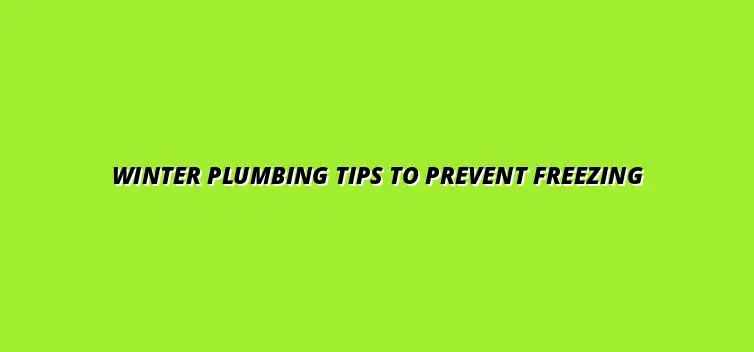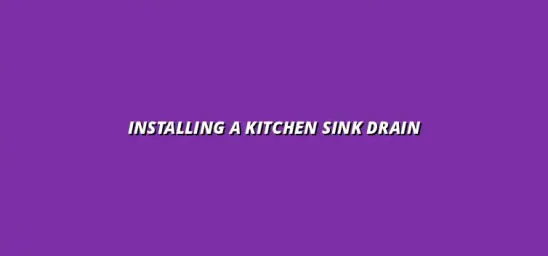
Winter Plumbing Tips to Prevent Freezing
Understanding the Importance of Winter Plumbing Maintenance
As the winter chill sets in, the importance of winter plumbing maintenance becomes glaringly clear for homeowners. Many people often overlook their plumbing until it's too late, leading to expensive repairs and damage. Proper maintenance not only protects your home but also ensures that your plumbing system operates efficiently during the cold months. For example, regular maintenance can help prevent plumbing emergencies and extend the life of your fixtures.
By taking a proactive approach to winter plumbing care, you can avoid common winter plumbing issues. Investing a little time and effort now can save you from costly repairs later on. Let's explore why winter plumbing maintenance is not just a good idea but essential for every homeowner!
Why Winter Plumbing Maintenance is Essential for Homeowners
During the winter months, the risk of plumbing problems increases significantly. The cold temperatures can lead to issues like frozen pipes, which can burst and cause major flooding in your home. Understanding these risks is crucial for any homeowner who wants to protect their property. Regular plumbing maintenance is key to avoiding these issues.
Here are a few reasons why winter plumbing maintenance is essential:
- Preventing costly repairs from burst pipes.
- Avoiding water damage to your home and belongings.
- Ensuring your plumbing system functions efficiently throughout the season.
- Enhancing the longevity of your plumbing fixtures.
The Risks of Freezing Pipes During Winter Months
Freezing pipes are one of the most significant risks homeowners face in winter. When temperatures drop, the water inside pipes can freeze and expand, leading to cracks or even total breaks. This not only disrupts your water supply but can also create a mess that requires immediate attention. Learning how to unclog your drains quickly can also be helpful in a plumbing emergency.
Some common risks associated with freezing pipes include:
- Increased water bills due to leaks.
- Extensive damage to walls, ceilings, and floors.
- Potential mold growth from water exposure.
Recognizing these risks early allows you to take steps to protect your plumbing, ensuring your home remains safe and dry throughout the winter months.
Proactive Strategies for Preventing Freezing Pipes
Taking proactive steps to prevent freezing pipes is essential for maintaining an efficient plumbing system during winter. There are several strategies you can implement to protect your pipes from the cold. By following these tips, you can enjoy peace of mind knowing that your plumbing is ready to weather the chill! Remember to also check out tips on maintaining your water heater efficiently.
Insulating Pipes: Techniques and Materials for Effective Protection
Insulating your pipes is one of the most effective ways to prevent freezing. Proper insulation keeps the heat inside the pipes, reducing the risk of ice formation. You have various options to choose from when it comes to insulation materials and techniques. Simple changes can also help you save water and reduce your bills.
- Foam pipe insulation: Easy to apply and effective for most pipe types.
- Heat tape: Provides warmth directly to pipes at risk of freezing.
- Fiberglass insulation: Good for larger pipes and areas with extreme cold.
Each material has its benefits, and selecting the right one can make a significant difference in your plumbing's resilience against the cold.
Choosing the Right Insulation for Different Pipe Types
Not all pipes are the same, and understanding which insulation works best for each type is key. For instance, exposed pipes in unheated areas like basements or crawl spaces need more attention than those within heated walls. Here’s a quick guide on choosing the right insulation:
- Plastic pipes: Foam insulation works well.
- Metal pipes: Heat tape is often recommended.
- Cold water pipes: Insulate with thicker materials to maintain temperature.
Tailoring your insulation to specific pipe types can help ensure that your plumbing system stays safe from freezing.
DIY Insulation Tips for Homeowners
Insulating pipes doesn't have to be a daunting task! Many homeowners can take simple steps to insulate their plumbing without calling in a professional. Here are some DIY tips that can help:
- Measure your pipes before buying insulation materials to get the right fit.
- Use zip ties or duct tape to secure insulation around pipes.
- Seal any gaps or cracks in walls where pipes run to reduce drafts.
With a little effort, you can enhance your plumbing's protection against the harsh winter cold!
Keeping the Heat On: Maintaining a Consistent Temperature
Another crucial strategy for preventing frozen pipes is to maintain a consistent temperature throughout your home. Fluctuations in temperature can lead to dangerous conditions for your plumbing. Keeping your home warm not only protects your pipes but also keeps you cozy! Proper kitchen sink maintenance can also prevent costly repairs.
To ensure consistent warmth, consider these tips:
- Keep the thermostat set to at least 55°F, even when away.
- Open cabinet doors under sinks to allow warm air to circulate.
- Let faucets drip slightly to keep water flowing through the pipes.
Understanding Temperature Thresholds for Pipe Safety
Knowing the temperature thresholds for pipe safety is vital. Most pipes can handle temperatures above 32°F without freezing. However, once the temperature dips to around 20°F or lower, the risk increases significantly. Paying attention to local weather reports can help you prepare for extreme cold. If you live in Birmingham and need a plumber, consider checking out this local service.
Here are some temperature thresholds to keep in mind:
- 32°F: Freezing point; immediate precautions should be taken.
- 20°F: High risk of freezing for uninsulated pipes.
- 10°F and below: Severe risk; extra measures are strongly advised!
Effective Heating Solutions for Vulnerable Areas
Identifying and heating vulnerable areas in your home is key to protecting your plumbing. Some spots, like basements, attics, and crawl spaces, are more susceptible to freezing. Implementing heating solutions in these areas can help keep your plumbing safe!
- Space heaters can be effective but ensure they’re used safely.
- Insulated curtains can help keep cold drafts away from windows.
- Consider installing heat lamps in particularly cold areas.
Draining and Winterizing Outdoor Plumbing Systems
Outdoor plumbing systems require special attention during winter. Failing to drain and winterize these systems can lead to significant issues, including frozen and burst pipes. Taking the time to properly prepare your outdoor plumbing can save you a lot of trouble!
Here are some essential steps to winterize your outdoor plumbing:
- Turn off the water supply to outdoor faucets.
- Drain any hoses and store them indoors to prevent freezing.
- Flush and drain sprinkler systems to avoid damage.
Steps to Properly Drain Hoses and Sprinklers
Winterizing hoses and sprinklers involves a few straightforward steps:
- Disconnect hoses from faucets and drain any remaining water.
- Inspect hoses for damage before storing them.
- For sprinklers, drain the system manually or use compressed air to blow out excess water.
By following these steps, you can protect your outdoor plumbing from winter's harsh conditions.
Winterizing Pools and Outdoor Faucets
Winterizing your pool and outdoor faucets is just as crucial as draining hoses. Pool water can freeze, leading to damage if not properly winterized. Here are some key steps to ensure your pool and faucets are ready for winter:
- Lower the water level in your pool and add winterizing chemicals.
- Cover the pool securely to keep debris out.
- Drain outdoor faucets, then cover them with insulated faucet covers.
Taking these precautions will help keep your outdoor plumbing safe from freezing damage.
Identifying Vulnerable Areas in Your Home
Knowing where your plumbing is most vulnerable can make a big difference in preventing freezing issues. Common problem spots often have inadequate insulation or exposure to cold drafts. By identifying these areas, you can take the necessary steps to protect them. Regular maintenance, as described in these plumbing maintenance tips, is crucial.
Here are some common vulnerable spots to watch out for:
- Exposed pipes in unheated areas like garages or basements.
- Pipes running along exterior walls.
- Areas with poor insulation, such as attics or crawl spaces.
Common Problem Spots for Freezing Pipes
Beyond identifying vulnerable areas, understanding common problem spots can help you know where to focus your winter plumbing maintenance efforts:
- Under sinks, especially on exterior walls.
- Near windows or doors where drafts are likely.
- In attics or basements where temperatures can drop significantly.
Taking the time to assess these problem spots can make all the difference in keeping your plumbing safe!
Conducting a Home Assessment for Plumbing Vulnerabilities
Conducting a home assessment is an excellent way to identify plumbing vulnerabilities. Walking through your home and checking for potential issues can reveal areas needing attention. Here’s how you can conduct an effective home assessment:
- Inspect all visible pipes for insulation and potential drafts.
- Check the temperature of unheated spaces and adjust heating as needed.
- Look for signs of previous leaks and address them immediately.
By being proactive and thorough in your assessment, you can ensure the safety and functionality of your plumbing during the winter months.
Responding to Signs of Potential Pipe Freezing
Winter can bring unexpected challenges, especially when it comes to plumbing. As temperatures drop, it's crucial for homeowners to be vigilant and aware of the signs that indicate potential pipe freezing. Early detection can save you from costly repairs and water damage. Let's look into how to recognize these symptoms effectively!
Being proactive in identifying frozen pipes can prevent a lot of hassle later on. If you notice anything unusual with your plumbing, it’s essential to act quickly. Not all pipes freeze at the same rate, so being attentive to changes in water flow and temperature can make a significant difference. Remember to always prioritize safety and consider calling a professional for severe issues.
Recognizing Symptoms of Frozen Pipes Early
The sooner you identify a frozen pipe, the better your chances of mitigating damage. Here are some common symptoms to look out for:
- Reduced Water Flow: A noticeable drop in water pressure can indicate a blocked or frozen pipe.
- Strange Sounds: If you hear gurgling or bubbling noises, it might mean water is struggling to move through the pipes.
- Frost on Pipes: Visible frost or ice on the outside of pipes is a clear sign that freezing is occurring.
- Unusual Odors: Stagnant water can lead to unpleasant smells, which may signal a frozen or clogged pipe.
Be aware that frozen pipes are often found in areas of your home that are poorly insulated or exposed to extreme cold. Regularly checking these areas can help catch issues before they escalate!
Common Indicators of Frozen Plumbing
Some additional indicators can help pinpoint freezing issues:
- Visible Cracks: Look for cracks or small leaks in exposed pipes, which can occur when pipes freeze and expand.
- Inconsistent Water Temperature: If the temperature of the water fluctuates unexpectedly, it may mean a frozen section is causing blockages.
- Unheated Spaces: Areas like attics, basements, and garages are more prone to freezing. Check these spots regularly!
It’s essential to stay alert and take these signs seriously. The quicker you respond, the less likely you are to face significant damage.
What to Do When You Suspect Frozen Pipes
If you suspect that you have frozen pipes, here’s what you can do:
- Turn Off the Water Supply: This prevents water from flowing if the pipe bursts.
- Apply Heat: Use a hairdryer or heating pad on the affected area to gently warm the pipe.
- Open Faucets: This allows pressure to release and may help thaw the pipe more quickly.
- Call a Plumber: If you can’t locate the frozen area or if the situation worsens, professional help is essential.
Don't hesitate to reach out for help! It's better to have an expert assess the situation than to risk further damage.
Frequently Asked Questions About Winter Plumbing Maintenance
Winter plumbing maintenance brings up a lot of questions for homeowners. Understanding what to do during the cold months can save time, money, and stress. Here are some frequently asked questions that might help clarify your concerns.
Can I Use Heat Tape on My Pipes?
Yes, heat tape can be an effective solution for preventing frozen pipes. However, it's essential to use it correctly to ensure safety:
- Choose the Right Type: There are two types: self-regulating and constant wattage. Make sure to select the appropriate one for your needs.
- Follow Instructions: Always read the manufacturer's guidelines to avoid overheating, which could lead to a fire hazard.
- Inspect Regularly: Check the heat tape for wear and tear, replacing it as necessary to ensure effectiveness.
Using heat tape correctly can provide extra protection during the cold months!
How Can I Tell If My Pipes Are Frozen?
Aside from the symptoms mentioned earlier, here are a few additional signs to look for:
- No Water Flow: If turning on a tap produces no water, it’s likely that the pipe is frozen.
- Temperature Differences: Feel the pipes; if one section feels significantly colder than the rest, it might be frozen.
- Water Hammer Sounds: A loud noise when turning on the faucet can indicate a blockage.
Recognizing these signs early can help you take action before damage occurs!
What Should I Do If a Pipe Bursts During Winter?
If you find yourself dealing with a burst pipe, act quickly:
- Shut Off the Water Supply: This is the first step to prevent further flooding.
- Drain the Pipes: Open faucets to drain any remaining water.
- Contact a Plumber: It’s best to get professional help to assess and repair the damage. For example, if you need help with kitchen plumbing, a professional can assist.
Knowing these steps can save you from costly repairs and potential hazards!
Summarizing Effective Winter Plumbing Practices
In summary, taking care of your plumbing during winter months is crucial. Recognizing the signs of potential issues can help you avoid bigger problems down the line. Let's highlight some key takeaways that every homeowner should keep in mind!
Key Takeaways for Homeowners to Remember
- Inspect and insulate vulnerable pipes before winter.
- Be aware of the signs of frozen pipes and act quickly.
- Consider professional help when facing complex plumbing issues.
By keeping these points in mind, you can keep your plumbing system running smoothly through the winter! Remember, being proactive is key.
Encouraging Regular Plumbing Check-Ups to Prevent Future Issues
Regular maintenance is vital in preventing winter plumbing problems. Scheduling check-ups with a professional plumber can detect issues early and save you from costly repairs. Make it a habit to assess your plumbing systems annually, focusing especially before the cold months arrive!
So, take the time to care for your plumbing. Regular maintenance not only extends the life of your plumbing but also ensures you stay warm and dry during those chilly winter months. Stay safe and enjoy your winter!





Fixing a Backed-Up Kitchen Sink
Prepare Your Plumbing for Weather
Installing a Kitchen Sink Drain
When to Replace Plumbing Fixtures
Fixing a Jammed Garbage Disposal